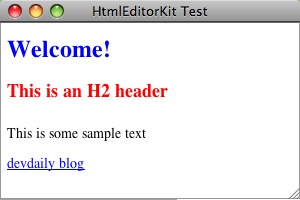| A best-selling programming book on Amazon | |

|
Clean Architecture: A Craftsmen’s Guide |
Did you know that you can use CSS styles when displaying HTML in a Java Swing application? It's pretty cool, and it can help spice up any simple HTML you may currently be showing in a Java-based editor or viewer. In this tutorial I'll share some source code that shows how this works.
If you haven't done it already in your own code, the first thing you need to do is create a JEditorPane, apply an HTMLEditorKit to your JEditorPane, then add it to a JScrollPane like this:
// create a JEditorPane JEditorPane jEditorPane = new JEditorPane(); // make it read-only jEditorPane.setEditable(false); // add a HTMLEditorKit to the editor pane HTMLEditorKit kit = new HTMLEditorKit(); jEditorPane.setEditorKit(kit); // now add it to a scroll pane JScrollPane scrollPane = new JScrollPane(jEditorPane);
Add CSS styles with the StyleSheet class
Next, you can use the Java StyleSheet class to add some CSS style to the way your HTML is presented. Just get an instance of the StyleSheet class from your HTMLEditorKit, and then add some styles ("rules") to it, as shown in this code:
// add some styles to the html
StyleSheet styleSheet = kit.getStyleSheet();
styleSheet.addRule("body {color:#000; font-family:times; margin: 4px; }");
styleSheet.addRule("h1 {color: blue;}");
styleSheet.addRule("h2 {color: #ff0000;}");
styleSheet.addRule("pre {font : 10px monaco; color : black; background-color : #fafafa; }");
Display it all
Later on, when you're ready to render and display the HTML code, just get the Document from your HTMLEditorKit, set it on the JEditorPane, and then -- assuming you have one String that contains all the HTML you want to render -- just set that HTML on the JEditorPane using the JEditorPane setText method, like this:
// create a document, set it on the jeditorpane, then add the html Document doc = kit.createDefaultDocument(); jEditorPane.setDocument(doc); jEditorPane.setText(htmlString);
Here's an example of some HTML text, with the styles that I've shown above applied to the plain HTML:

As you can see, it's relatively simple to add some CSS styles like this to help spice up some plain HTML content. Using this technique, one portion of your code can render simple HTML content, and then you can add these CSS "rules" to make the HTML look the way you want it to look.
| A Programming Classic! | |

|
The Pragmatic Programmer |



